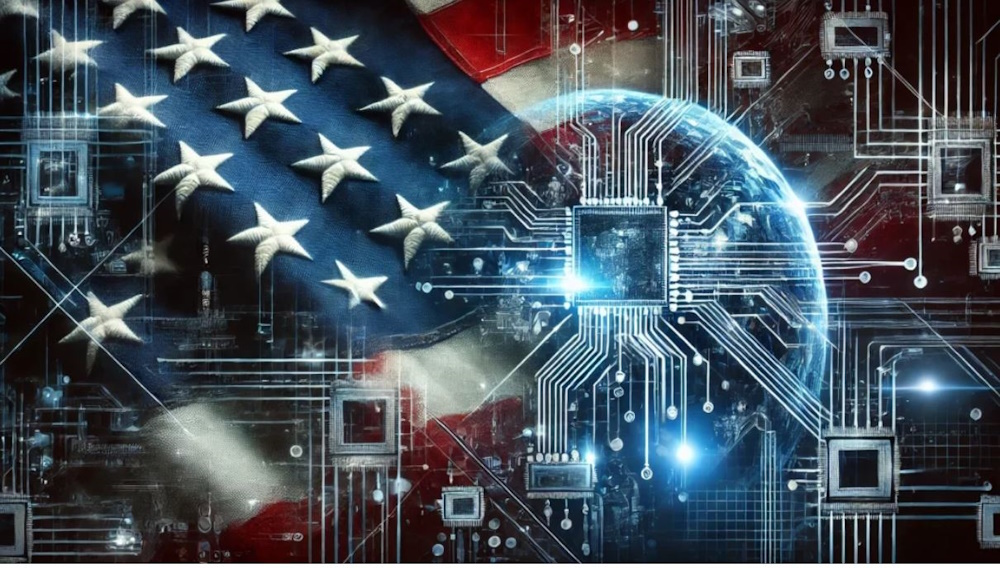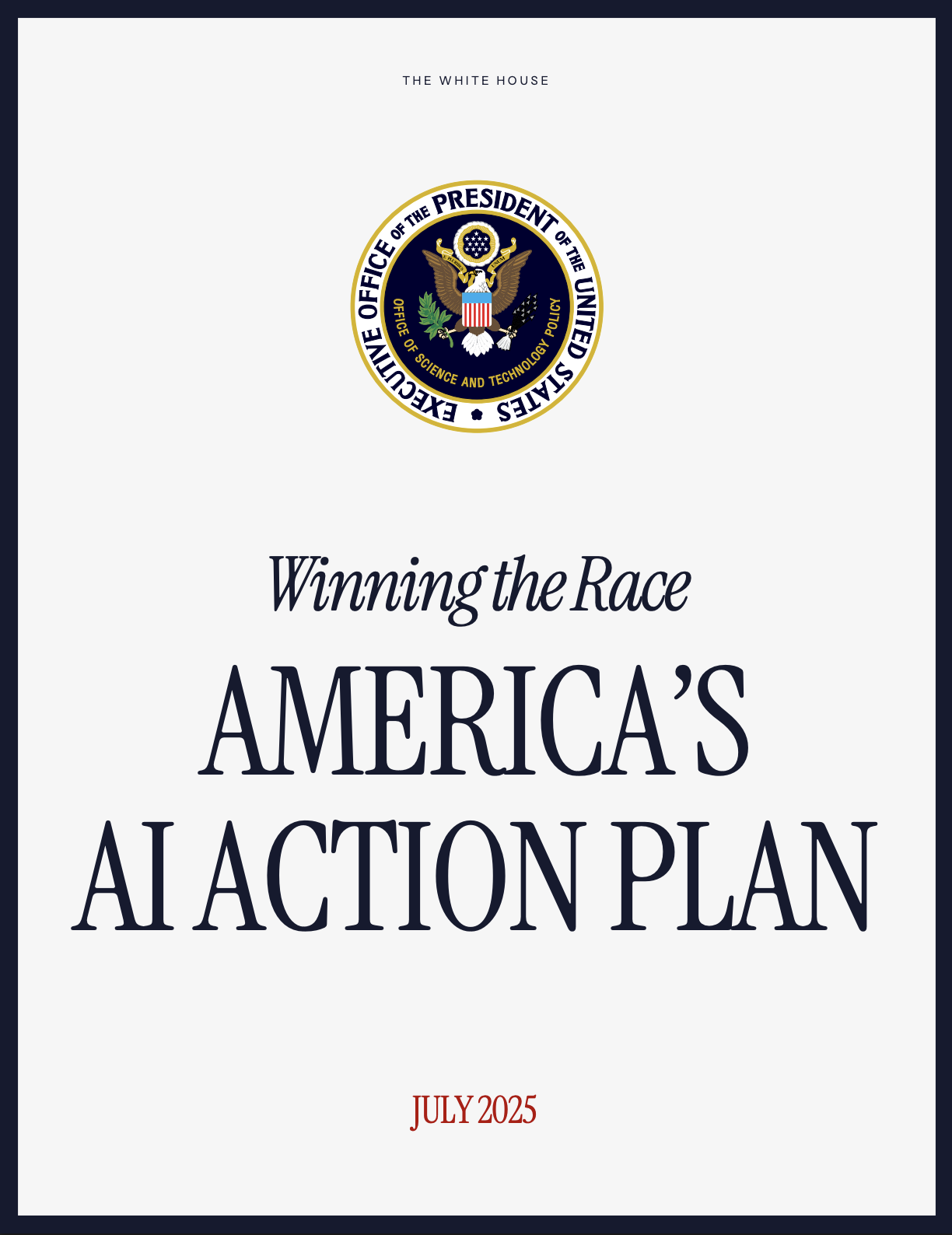 AI Action Plan
AI Action Plan
America's global leadership in AI
Related: Governance | DOGE | America's AI Vision | AI Planning Input
President Donald Trump's plan and orders to promote America's AI dominance
Fulfilling an earlier promise, President Donald Trump unveiled a sweeping Artificial Intelligence (AI) Action Plan on 23 July 2025, aiming to ensure America's global leadership in AI through rapid innovation, expansive infrastructure, and active deregulation. Central to the plan is the ambition to "win the AI race," secure economic competitiveness, and ensure national security in the face of rising international competition; primarily from China.
The three key aims of the plan involve accelerating AI innovation, building an AI infrastructure, and leading in international AI diplomacy and security.

The president's proposal, released on July 23rd, is a sweeping endorsement of the technology, full of guidance that ranges from specific executive actions to directions for future research.
"AI is far too important to smother in bureaucracy at this early stage, whether at the state or Federal level," the plan says. "The Federal government should not allow AI-related Federal funding to be directed toward states with burdensome AI regulations that waste these funds, but should also not interfere with states' rights to pass prudent laws that are not unduly restrictive to innovation."
To promote the use of AI, the White House encourages a "try-first" culture for AI across American industry. This includes creating domain-specific standards for adopting AI systems and measuring productivity increases, as well as regularly monitoring how US adoption of AI compares to international competitors. The White House also wants to integrate AI tools throughout the government itself, including by detailing staff with AI expertise at various agencies to other departments in need of that talent, training government employees on AI tools, and giving agencies ample access to AI models. The plan also specifically calls out the need to "aggressively adopt AI within its Armed Forces," including by introducing AI curricula at military colleges and using AI to automate some work. The administration says it wants to "create a supportive environment for open models," or AI models that allow users to modify the code that underpins them. Open models have certain "pros," like being more accessible to startups and independent developers.
President Trump signed an executive order to fast track permitting for data center projects. The EO directs the commerce secretary to "launch an initiative to provide financial support" that could include loans, grants, and tax incentives for data centers and related infrastructure projects. Trump's plan directs agencies to identify federal lands suitable for the "large-scale development" of data centers and power generation. The EO tells the Department of Defense to identify suitable sites on military installations and the Environmental Protection Agency (EPA) to identify polluted Superfund and Brownfield sites that could be reused for these projects.
The plan admits that AI is a big factor "increasing pressures on the [power] grid." Electricity demand is rising for the first time in more than a decade in the US, thanks in large part to data centers, a trend that could trigger blackouts and raise Americans' electricity bills. President Trump's AI plan lists some much-needed fixes to stabilize the grid, including upgrading power lines and managing how much electricity consumers use when demand spikes.

The Trump administration notes that while developers and engineers know how today's advanced AI models work in a big-picture way, they "often cannot explain why a model produced a specific output. This can make it hard to predict the behavior of any specific AI system." It's aiming to fix that, at least when it comes to some high-stakes use cases.
The plan states that the lack of AI explainability and predictability can lead to issues in defense, national security, and "other applications where lives are at stake," and it aims to promote "fundamental breakthroughs on these research problems." The plan's recommended policy actions include launching a tech development program led by the Defense Advanced Research Projects Agency to advance AI interpretability, control systems, and security. It also said the government should prioritize fundamental advancements in such areas in its upcoming National AI R&D Strategic Plan and, perhaps most specifically, that the DOD and other agencies should coordinate an AI hackathon to allow academics to test AI systems for transparency, effectiveness, and vulnerabilities. The plan also discusses how to better evaluate AI models for performance and reliability, like publishing guidelines for federal agencies to conduct their own AI system evaluations for compliance and other reasons.
The plan recommends creating new ways for the research and academic community to access AI models and compute. The way the industry works right now, many companies and academic institutions can't access or pay for the amount of compute they need on their own, and they often have to partner with providers of large-scale cloud computing infrastructure, like Amazon, Google, and Microsoft. The plan wants to fix that issue, saying that the US "has solved this problem before with other goods through financial markets, such as spot and forward markets for commodities." It recommends collaborating with the private sector, as well as government departments and the National Science Foundation's National AI Research Resource pilot to "accelerate the maturation of a healthy financial market for compute."
 Key Pillars of the AI Action Plan
Key Pillars of the AI Action Plan
Accelerate AI Innovation
- Stripping Federal Regulations: Calls for reviewing and eliminating federal regulations that may "interfere with" the rapid development and deployment of AI in both the public and private sectorschannel.
- Reducing Oversight: The plan intentionally reduces federal regulatory oversight, marking a significant shift from the U.S. regulatory model under previous administrations.
- Updating Procurement Standards: Requires government agencies to procure only large language models (LLMs) that are "objective" and "free from ideological bias," explicitly pushing back on diversity, equity, and inclusion (DEI) influences in AI models purchased by the government.
Build American AI Infrastructure
- Data Centers & Chips: Expedited permits for the construction of new data centers and semiconductor fabrication plants are key features, with aims to rapidly scale the physical backbone supporting U.S. AI efforts.
- Energy Generation: Policies support the development of energy infrastructure needed to power resource-intensive AI systems.
- National Initiatives: New programs to boost high-demand jobs such as electricians and HVAC technicians are planned to support the infrastructure boom.
Lead in International AI Diplomacy and Security
- AI Export Packages: The Commerce and State Departments will partner with industry to create "full stack" AI exports, including hardware, software, models, and standards for allied nations. The goal is to set American tech as the global benchmark and counter Chinese influence.
- Opposition to State-by-State Rules: The administration is pressing for a unified, nationally-driven policy, discouraging individual U.S. states from enacting their own AI regulations that might restrict innovation or deployment.
 Executive Orders
Executive Orders
Executive Order 14179, titled "Removing Barriers to American Leadership in Artificial Intelligence" was signed on January 23, 2025, revoked Biden-era AI policies (EO 14110), and initiated a 180-day timeline for crafting a new federal AI Action Plan. The executive order aims to achieve the following goals:
- Initiate the process of strengthening US leadership in AI
- Promote AI development free from ideological bias or social agendas
- Establish an action plan to maintain global AI dominance
- Revise or rescind policies that conflict with these goals
Executive Orders signed on 23 July 2025:
- Promoting the Export of the American AI Technology Stack
- Accelerating Federal Permitting of Data Center Infrastructure
- Preventing Woke AI in the Federal Government